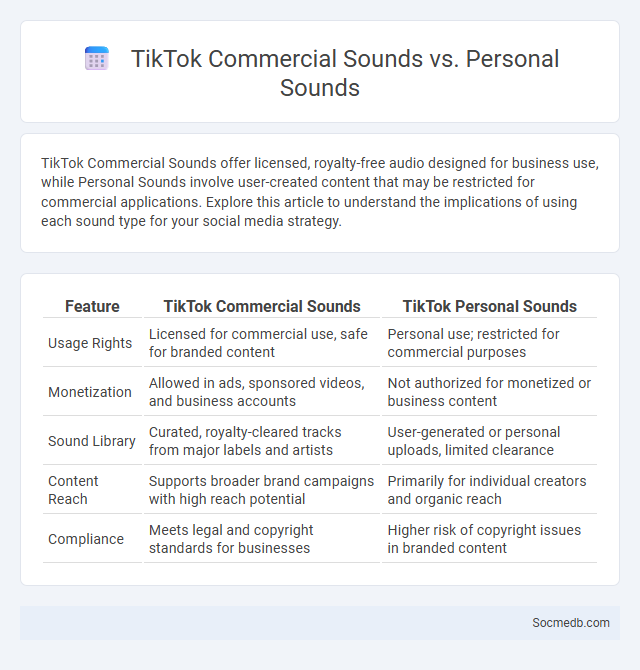
Photo illustration: TikTok Commercial Sounds vs Personal Sounds
TikTok Commercial Sounds offer licensed, royalty-free audio designed for business use, while Personal Sounds involve user-created content that may be restricted for commercial applications. Explore this article to understand the implications of using each sound type for your social media strategy.
Table of Comparison
| Feature | TikTok Commercial Sounds | TikTok Personal Sounds |
|---|---|---|
| Usage Rights | Licensed for commercial use, safe for branded content | Personal use; restricted for commercial purposes |
| Monetization | Allowed in ads, sponsored videos, and business accounts | Not authorized for monetized or business content |
| Sound Library | Curated, royalty-cleared tracks from major labels and artists | User-generated or personal uploads, limited clearance |
| Content Reach | Supports broader brand campaigns with high reach potential | Primarily for individual creators and organic reach |
| Compliance | Meets legal and copyright standards for businesses | Higher risk of copyright issues in branded content |
Understanding TikTok Sounds: Commercial vs Personal
Understanding TikTok sounds is essential for crafting engaging content that resonates with your audience. Commercial sounds, often licensed for marketing purposes, differ from personal sounds created by individual users and typically carry a more authentic, relatable vibe. By strategically using commercial sounds for brand promotion and personal sounds for genuine interaction, you can optimize your TikTok presence and enhance viewer engagement.
What Are TikTok Commercial Sounds?
TikTok commercial sounds are pre-approved audio clips licensed for use in branded content and advertisements on TikTok's platform, designed to ensure legal compliance and copyright protection. These sounds come from a vast library of music tracks, sound effects, and voice-overs specifically cleared for commercial use by businesses and content creators. Leveraging TikTok commercial sounds enhances brand visibility while avoiding copyright claims and potential account restrictions.
Defining Personal Sounds on TikTok
Defining personal sounds on TikTok involves customizing audio clips that uniquely represent an individual's style and creativity, enhancing user engagement and content recognition. These personalized sounds help creators build a distinct online identity, driving higher interaction rates and follower growth. Leveraging TikTok's algorithm, custom sounds increase visibility by encouraging trends and user-generated content replication.
Copyright Basics: How TikTok Handles Music Rights
TikTok uses a combination of licensing agreements with major music labels and music publishers to legally provide access to millions of songs for its users. The platform employs automated content recognition technology to detect copyrighted music and enforce usage rules, ensuring creators respect music rights while enabling creative expression. Users uploading original sounds or covers must adhere to TikTok's copyright policies to avoid content removal or account penalties.
Key Differences Between Commercial and Personal Sounds
Commercial sounds in social media are meticulously designed to enhance brand identity and increase user engagement, often featuring catchy jingles, professional voice-overs, and signature tones that align with marketing goals. Personal sounds tend to be informal, spontaneous, and reflect individual expression, including casual voice notes, ambient background noise, and trending audio clips shared among friends. The key difference lies in the intent and production quality, where commercial sounds prioritize consistency and brand recall, while personal sounds emphasize authenticity and relatability.
How Copyright Affects Sound Usage on TikTok
Copyright laws strictly regulate sound usage on TikTok, requiring users to obtain proper licenses for music and audio clips. Unauthorized use of copyrighted sounds can result in video removal, account suspension, or legal action due to infringement claims. TikTok enforces these rules through automated content ID systems and collaborations with music rights holders to ensure compliance and protect intellectual property.
Business Accounts: Restrictions and Opportunities
Business accounts on social media platforms offer significant opportunities for brand visibility, targeted advertising, and customer engagement, yet they face restrictions such as limited organic reach and stringent content guidelines. You must navigate rules like advertising policies, data privacy regulations, and platform-specific limitations to maximize ROI and maintain compliance. Leveraging analytics tools and consistent content strategies helps businesses optimize their social presence despite these constraints.
Tips to Avoid Copyright Strikes on TikTok
To avoid copyright strikes on TikTok, use original content or licensed music from TikTok's royalty-free library to ensure compliance with platform policies. Regularly review TikTok's copyright guidelines and promptly remove or edit videos flagged for potential infringement. Leveraging tools like TikTok's Sound Library and respecting creators' intellectual property significantly reduces the risk of copyright violations.
Creative Strategies for Using Legal Sounds
Creative strategies for using legal sounds on social media include sourcing royalty-free audio libraries and utilizing platforms that offer licensed soundtracks for user-generated content. Incorporating unique sound bites, ambient noises, or custom-composed music can enhance your visual storytelling while ensuring compliance with copyright laws. You can elevate your content's engagement and reach by combining legally safe sounds with trending topics and original visuals.
Future Trends in TikTok Sound Copyright Policies
TikTok's sound copyright policies are evolving to address increasing concerns over intellectual property rights, with future trends including enhanced licensing agreements and real-time automated content identification to protect creators. You will likely see stricter enforcement measures combined with more transparent royalty distribution systems, ensuring fair compensation for original sound creators. These changes aim to balance user creativity with legal compliance, shaping the platform's landscape for sound usage in upcoming years.
 socmedb.com
socmedb.com